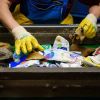Upcycling is becoming popular
Creating useful things from waste is the basic idea behind upcycling. It reduces the strain on the environment and your wallet.

Disposable was yesterday, recycling is the thing of the future. “Upcycling” is the latest trend. This rather dynamic-sounding activity has actually been done for a long time: old or discarded things are given a new function and upgraded as a result. For example? Flip-flops made out of car tyres, bags made out of plastic bottles and seating furniture made out of pallets. In many developing countries upcycling is part of everyday life. In Germany, too, the older generation still remember, for example, how bike locks were made out of electricity cables in the immediate post-war years – in keeping with the motto: “Necessity is the mother of invention.”
A new use for an old product
Why upcycling has enjoyed growing popularity in Germany and other industrialised nations in recent years can be explained by people’s desire for individuality and uniqueness. Everything associated with creativity, handicraft and do-it-yourself activity has attracted more interest than ever before. Upcycling captures the spirit of the time. This trend was recognised very early on by Stanislaus Teichmann and Eric Pieper of Upcycling Deluxe in Berlin. For three years now, in their shop on Kastanienallee they have been selling hats made out of old coffee sacks, earrings made of Lego bricks, key boards made of books and wallets made out of packaging materials. “We wanted to do something sustainable,” says Teichmann. Unlike recycling, upcycling increases the value of the raw material by putting it back into the product and trade cycle, explains the shop proprietor.
Germany is a leader when it comes to re-using waste. Almost no other country in Europe recycles more material – over 70% of all packaging waste. However, according to a recent study, every German citizen is responsible for 614 kilograms of waste a year – that is 131 kilograms more than the average European. People who use an empty wine barrel as a kennel, grandma’s old silver spoon as a wall hook or their old computer as a letterbox do not only have unique original objects, they also do something for the environment.

